You are not logged in. Would you like to login?

The character of any board is determined by the posters themselves.
This place will be as good as you participants make it.
Please read the rules and behave accordingly.
With the exception of "The Back Alley", CIVIL DISCUSSION IS EXPECTED
Any problems, you may email at cpd.monitors@gmail.com - Send private forum message - OR Ask A Question here
Any and all personal information will remain strictly confidential.
Click BOLDED FORUM TITLES to open each one.
For help navigating & posting on the forums using BBCode, Get Help Here
We are currently NOT ACCEPTING new registrations. If you want to join, post a message on the simple message board that you'd like a membership here too.
- Siagiah
- Administrator
 Offline
Offline - From: New England, U.S.A.
- Registered: 2/16/2019
- Posts: 2,789
Israel's settlements: 50 years of land theft explained
Israel's settlements: 50 years of land theft explained
Produced by Zena Tahhan Published on November 21, 2017
Fifty years ago, the UN Security Council passed Resolution 242. The resolution is used as a framework for implementing the two-state solution to the Palestinian-Israeli conflict.
But since its adoption in 1967, Israel has violated the resolution by entrenching its occupation of the Palestinian territories through illegal settlements.
600,000 - 750,000 Illegal settlers in the occupied Palestinian territories
150 Settlements
119 Outposts
42% Of West Bank land controlled by settlements
86% Of East Jerusalem for Israeli state and settler use
The majority of settlements have been built either entirely or partially on private Palestinian property
To the casual visitor or tourist driving through the occupied West Bank or Jerusalem, Israeli settlements may appear as just another set of houses on a hill.
The middle-class suburban style townhouses, built fast and locked in a grid of uniform units, stand like fortified compounds, in direct contrast to the sprawling limestone Palestinian homes below.
Settlement homes, mostly constructed of cement with a cosmetic limestone cladding, tend to fashion a similar look: American-style villas topped by red-tiled roofs and surrounded by lush, neatly trimmed green lawns.
The largest settlement, Modi'in Illit, houses more than 64,000 Israeli Jews in the occupied West Bank. The mega-settlement has its own mayor, as well as schools, shopping malls and medical centres.
Some settlements even have their own universities.


Today, between 600,000 and 750,000 Israelis live in these sizeable settlements, equivalent to roughly 11 percent of the total Jewish Israeli population.
They live beyond the internationally recognised borders of their state, on Palestinian land that Israel occupied in 1967, comprising East Jerusalem and the West Bank.
Since then, the Israeli government has openly funded and built settlements for Israeli Jews to live there, offering incentives and subsidised housing.
So why have these housing compounds caused so much rancour and been called a threat to the prospect of peace in the Holy Land?
Follow this journey to find out.
What are settlements and how did they come about?
Contrary to common belief, settlements are a legacy of the pre-1948 period, before the creation of Israel.
In the 1880s, the community of Palestinian Jews, known as the Yishuv, amounted to three percent of the total population. They were apolitical and did not aspire to build a modern Jewish state.
But in the late 19th century, the Zionist movement - a political ideology - grew out of Eastern Europe, claiming that Jews were a nation or race that deserved a modern “Jewish state”.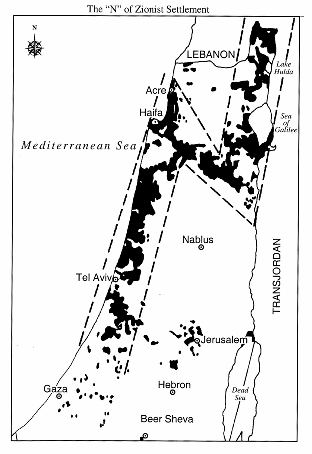
Source: Jewish Virtual Library
The movement, citing the biblical belief that God promised Palestine to the Jews, began to buy land there and build settlements to strengthen their claim to the land.
At the time, these settlements, built largely on the coastal plain and in the north of the country, were called “Kibbutzim” and “Moshavim”.
The first Kibbutz Degania, was established in 1909 by European Jewish colonists. Tel Aviv, now the economic capital of Israel, was also built in the early 20th century and was one of the first settlements.
The approach is known as “creating facts on the ground” - laying a stake in an area to ensure that it will be part of a future state and difficult to get rid of later on.
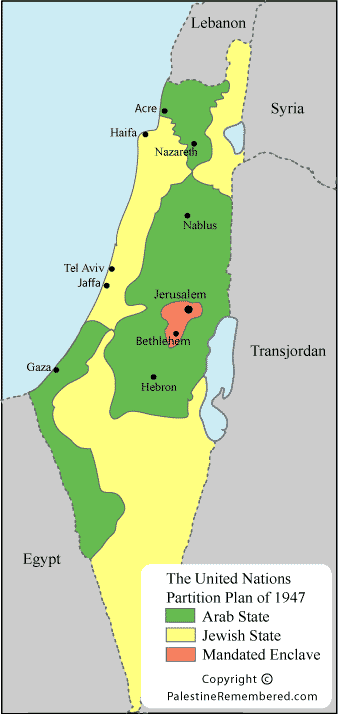
Source: PalestineRemembered.com
The distribution of the settlements determined the map of the proposed United Nations Partition Plan for Jewish and Palestinian states in 1947.
By 1948, prior to the ethnic cleansing of Palestine by the Zionist movement, Jews had control over less than six percent of the land.
According to Israeli statistics, there were some 80 kibbutzim and moshavim before 1948. However, in 1950 = 214 kibbutzim and 67,550 total population
What happened in 1948?
As European Jews began to colonise Palestine - many pushed by anti-Semitic persecution in Europe - the balance of land control between Palestinians and immigrant Jews shifted significantly.
The project was facilitated by the British, who were occupying Palestine from 1917 to 1947, with the aim of building a Jewish state.
Between 1922 and 1935, the Jewish population rose from nine percent to nearly 27 percent of the total population, displacing tens of thousands of Palestinian tenants from their lands as Zionists bought land from absentee landlords.
Under the 1947 UN Partition Plan, Jews were allocated 55 percent of the land, encompassing many of the main cities with Palestinian Arab majorities and the important coastline from Haifa to Jaffa.
The plan would deprive the Palestinian state of key agricultural lands and seaports, which led the Palestinians to reject the proposal.
Shortly after the issuance of UN Resolution 181 that called for partition, war broke out between Palestinian Arabs and Zionist armed groups, who, unlike the Palestinians, had gained extensive training and arms from fighting alongside Britain in World War II
The loss of land in Palestine
Zionist paramilitary groups launched a violent process of ethnic cleansing in the form of large-scale attacks, massacres, and destruction of entire villages aimed at the mass expulsion of Palestinians to build the Jewish state. By the end of 1949, the Jewish state had taken up some 78 percent of historical Palestine.
Of the remaining Palestinian territories, the West Bank and East Jerusalem came under Jordan's control, while Gaza was placed under Egyptian control.
The international community recognised Israel based on the 1948 borders.
But less than 20 years later - in 1967 - another Arab-Israeli war broke out. During the fighting, Israel militarily occupied the rest of historical Palestine, consisting of East Jerusalem, the West Bank and Gaza.
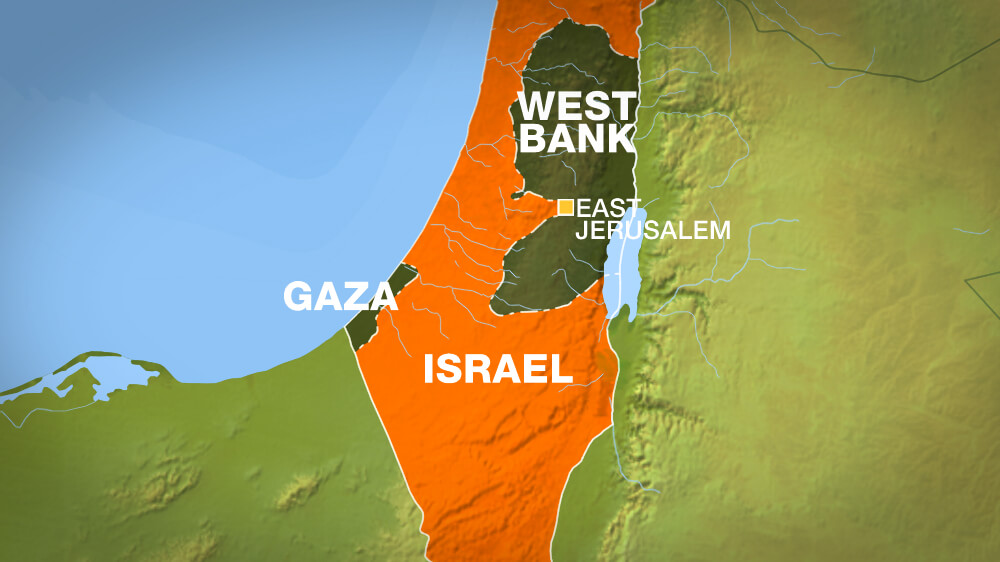
Israel also occupied the Egyptian Sinai Peninsula and the Syrian Golan Heights. With the exception of the Sinai Peninsula, all the other territories remain occupied until today.
In response, the UN Security Council members voted unanimously for Resolution 242 on November 22, 1967 - exactly fifty years ago.
The resolution stated that Israel must withdraw from the territories it seized in the war and formed the basis for all ensuing diplomatic negotiations on the Israeli-Palestinian conflict on the concept of “land for peace”.
Israel, however, did not accept the resolution and continues to violate it to this day, 50 years later, by building settlements on the territories meant for a Palestinian state.
What Israel did with Jerusalem
Shortly after the 1967 war, Israel illegally annexed East Jerusalem and declared it part of its “eternal, undivided” capital.
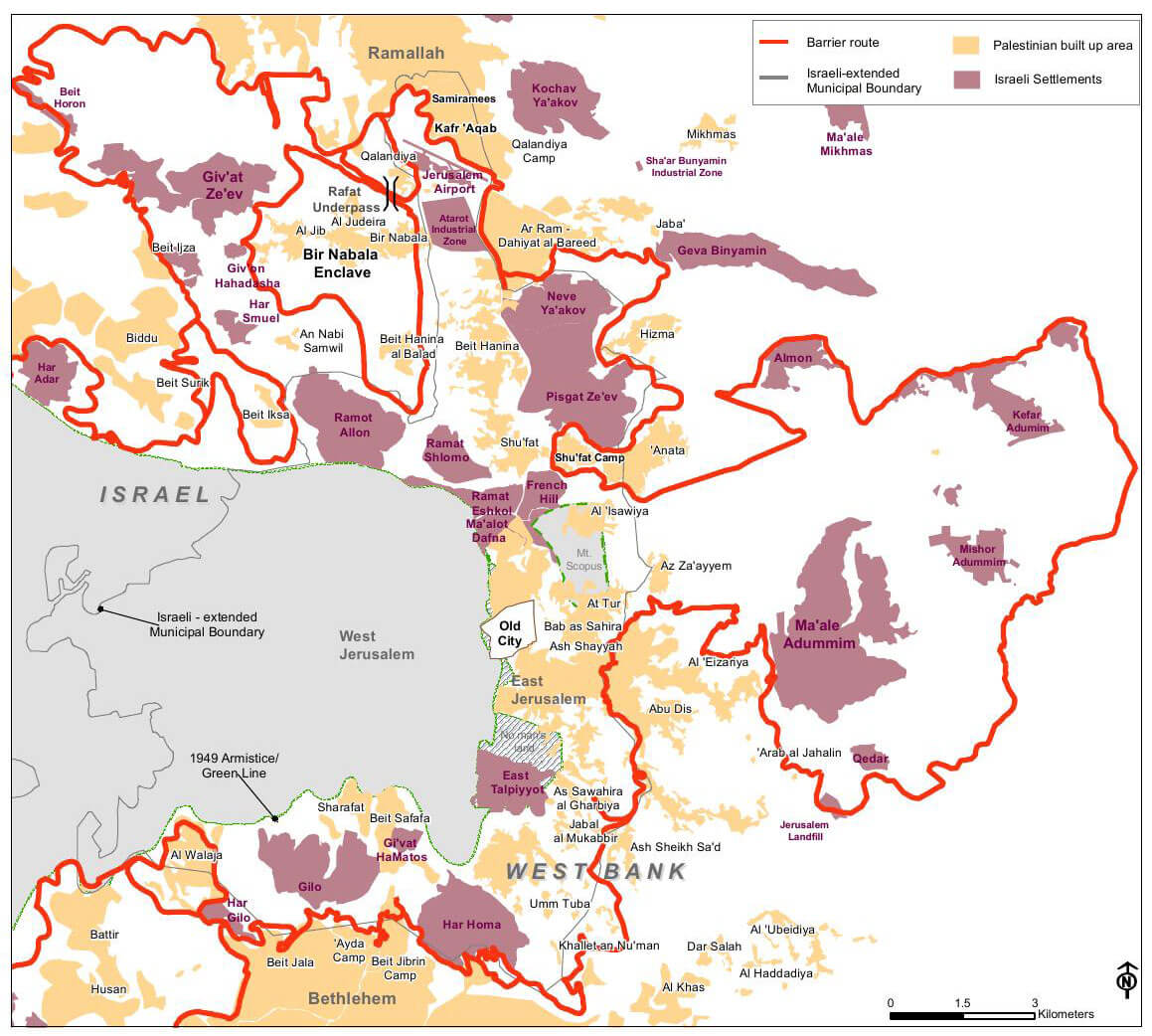 Map of East Jerusalem in 2007 shows the separation wall (in red) and the Israeli settlements in purple on areas of the occupied West Bank illegally annexed to Jerusalem.
Map of East Jerusalem in 2007 shows the separation wall (in red) and the Israeli settlements in purple on areas of the occupied West Bank illegally annexed to Jerusalem.
Source: United Nations Office for the Coordination of Humanitarian Affairs
This meant that it extended its law to East Jerusalem and claimed it as part of Israel, unlike the West Bank, which it physically occupies but does not claim.
The annexation of East Jerusalem is not recognised by any country in the world as it violates several principles of international law, which outlines that an occupying power does not have sovereignty in the territory it occupies.
The international community, including the US, officially regards East Jerusalem as occupied territory.
However, since Israel considers East Jerusalem part of its state, it calls the settlements there “neighbourhoods”.
Israel's settlement project after 1967: How is it different?
When the guns fell silent in 1967, the Israeli state began building colonies, or settlements, for its Jewish Israeli citizens on Palestinian land it had just occupied.
Settlements have become the hallmark of the Israeli colonial project in Palestine.
In the last 50 years, the Israeli government has transferred between 600,000 and 750,000 Jewish Israelis to the West Bank and East Jerusalem. They live in at least 160 settlements and outposts.
This means that roughly 11 percent of Israel's 6.6 million Jewish population now lives on occupied land, outside the internationally recognised borders of Israel.
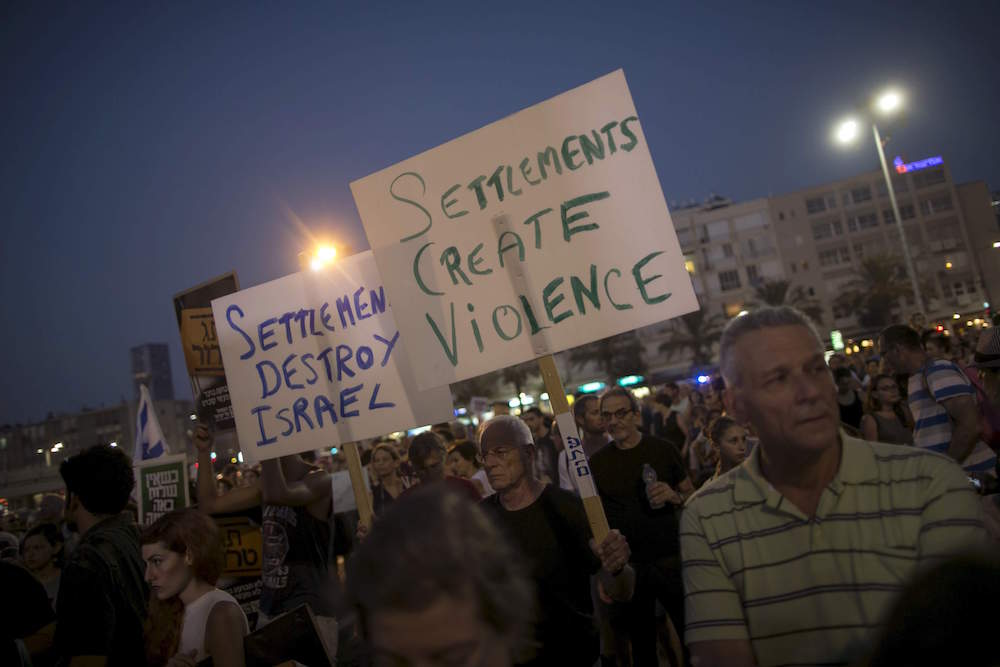
Left-wing Israeli protesters hold signs during a protest in Tel Aviv condemning an attack by settlers that killed an 18-month Palestinian baby in 2015 in the occupied West Bank. Source: [REUTERS/Baz Ratner]
The dilemma of the settlements and the occupation has effectively split Israelis between those who believe it is their God-given right to settle land that was promised to the Jewish people, and others who believe the settlements are a death sentence for the Jews.
To religious Jews, the outcome of the 1967 war and the seizure of the remainder of historical Palestine - particularly East Jerusalem, which houses the Old City - led to a sense of euphoria.
Thousands of Jews, including secular Jews, flocked to the Western Wall, also known as the al-Buraq Wall to Muslims. They wept as they gave thanks for what they believed was a miracle from God.
The majority of Israeli Zionist leftists who oppose the settlement project however, believe in the Jewish state along 1948 borders and reject Israel's expansion into the occupied territories.
To Palestinians, Israel's occupation and the settlement project did not come as a surprise; the Zionist movement was founded by non-natives to colonise the land, just as they did in 1948.
Munir Nuseibah, a law professor at al-Quds University in Jerusalem, says the occupation and the settlement project “reminded the world of the colonial aspects of Israel”.
Why are they illegal under international law?
In a series of agreements known as the Geneva Conventions, formulated in the aftermath of World War II, the international community established a set of accepted rules and standards for the protection of civilians, prisoners and injured people in times of war.
Under the Fourth Geneva Convention, which defines humanitarian protections for civilians caught in a war zone, an occupying power is forbidden from transferring parts of its civilian population into the territory it occupies.
The rationale behind this is simple.
1. To ensure that the occupation is temporary and allow for a solution to the conflict by preventing To ensure that the occupation is temporary and allow for a solution to the conflict by preventing the occupying power from acquiring long-term interests through military control.
2. To protect occupied civilians from theft of resources by the occupying power.
3. To prohibit a de facto situation in which two groups living on the same land are subject to two different legal systems, i.e. apartheid.
4. To prevent changes in the demographic makeup of the occupied territory.
But the Israeli government maintains that the status of the Palestinian territories is ambiguous, as there was no internationally recognised government in the territories prior to the 1967 war. The Israeli government argues that it took the territory from Jordan, which had control of the West Bank and East Jerusalem between 1949 and 1967, while Egypt had control of the Gaza Strip.
Israel regards the West Bank as “disputed” territory and thus refutes the existence of a military occupation there; saying the Fourth Geneva Convention does not apply. But the UN, the International Committee of the Red Cross, the International Court of Justice, and the international community have all affirmed that it does.
Israel also denies that any of the settlements were built on private Palestinian land.
What types of settlements are there?
There are three main types of Israeli colonies in the occupied Palestinian territories, all of which involve seizing Palestinian land and are all illegal under international law.
Settlements
Built by the Israeli government, mainly in rural areas in the West Bank and Jerusalem, many are on private Palestinian property and within close proximity to Palestinian towns and cities,
After the signing of the Oslo Accords in the early 1990s, the Israeli government stopped officially building new settlements but expanded existing ones,
In 2017, Israel started building the first new settlement in two decades.
Outposts
Built without the official authorisation of the Israeli government but with financial support from Israeli politicians and government ministries,
Illegal under Israeli law, but usually retroactively approved as official settlements,
In 2017, Israel passed a land-theft law that allows the legalisation of outposts provided the settlers could prove ignorance that they had built on privately owned land or under state orders.
Jerusalem's enclaves
Established mainly by Israeli right-wing organisations with the help of the Israeli government in the heart of Palestinian neighbourhoods in East Jerusalem,
Some involve taking over Palestinian homes and evicting their residents using Israeli laws that favour Jews over non-Jews,
Of the 200,000 Israeli Jews that live in East Jerusalem settlements, some 2,000 live in the midst of Palestinian neighbourhoods under army protection
How does Israel take over land?
Israel has developed a myriad of ways to seize Palestinian land.
Since Israel has not annexed the occupied West Bank and does not have jurisdiction there, it uses military orders as well as its own interpretations of Ottoman, British and Jordanian laws to seize Palestinian property.
In East Jerusalem however, the state applies Israeli law, despite the fact that the territory is considered occupied under international law, and the Palestinians who live there are not Israeli citizens.
Declaration of “state land”
Israel has declared at least 26 percent of the West Bank as “state land”.
Using a different interpretation of Ottoman, British and Jordanian laws, Israel stole public and private Palestinian land for settlements under the pretext of “state land”.
Though many Palestinians had paid taxes and cultivated their land for decades, most land wasn't registered during the Ottoman and British occupations; in 1968, Israel stopped the process of land registration and declared any unregistered land as belonging to the Israeli government.
Settlements on “state land” often expand into surrounding, privately owned, Palestinian land.
As an occupying power, Israel does not own the West Bank and is not permitted under international law to seize land in this manner.
Expropriation for “public needs”
Based on the law in the West Bank, a state is only allowed to expropriate private land for public Palestinian needs.
Israel uses this law, however, to confiscate private land for building Jewish-only settlement roads, connecting them with one another and to Israel.
Using a similar law in East Jerusalem, Israel built the 12 settlements in East Jerusalem on Palestinian property declared “for public needs”.
Requisition of land for “military needs”
This allows the Israeli army to issue a “temporary” seizure order on private land, after which the ownership of the area is transferred to Israel,
As opposed to expropriation, this law leaves the plot of land under the name of the original owners until the army no longer needs the land, but the areas have almost never been returned to their Palestinian owners.
Since 1967, the Israeli army has used this pretext to seize land for at least 42 settlements, maintain “secure zones” around the settlements, build bypass roads that allow soldiers and settlers to travel without having to cross Palestinian cities, and construct the separation wall.
Absentee land
In 1950, Israel introduced the Absentee Property Law to confiscate the property of the 800,000 Palestinians who were forced to flee their homes between 1947 and 1949, due to the Nakba.
The law encompassed those Palestinians who were displaced to the West Bank, East Jerusalem, Gaza, or to neighbouring countries.
Israel claimed that it would use the law to protect private properties until the refugees could return, but simultaneously banned them from returning and sold their land to Jewish Israelis,
After the 1967 war and occupation of the West Bank, Israel applied this law in the form of a military order that saw the transfer of all property belonging to Palestinian refugees who left the West Bank during 1967 to the Israeli government,
In 2015, the Israeli government made this law applicable to East Jerusalem and used it to seize private property of Jerusalem refugees in the West Bank or Gaza who are forbidden from returning to their homes.
This legislation is illegal under international law, which stipulates the need to respect the right of private property and prohibits its expropriation after the termination of war.
Why the locations of settlements matter
Settlements are scattered across the West Bank in a way that makes a contiguous Palestinian state impossible, while in Jerusalem the Israeli government has built settlements around the city to consolidate control over it.
These “ring neighbourhoods” are a set of major settlement blocs to the north, east and south of the Jerusalem, which Israel hopes to annex to its state.
The ring settlements have effectively cut off the West Bank's north from the south, impeding the ability of Palestinians to travel between cities in a normal fashion.
The building of these Jewish settlements around the city was not random but rather tells of a deeper Israeli political aim.
After the 1967 war and the Israeli occupation of East Jerusalem, Teddy Kollek, the mayor of the contested city, said in 1968: “The object is to ensure that all of Jerusalem remains forever a part of Israel. If this city is to be our capital, then we have to make it an integral part of our country, and we need Jewish inhabitants to do that.”
Indeed, Israel formalised its annexation of the eastern half of the city in 1980 when it passed the Jerusalem Law, claiming that “Jerusalem, complete and united, is the capital of Israel”, in violation of international law, which states that the city should be administered by the UN for its importance to the three Abrahamic religions.
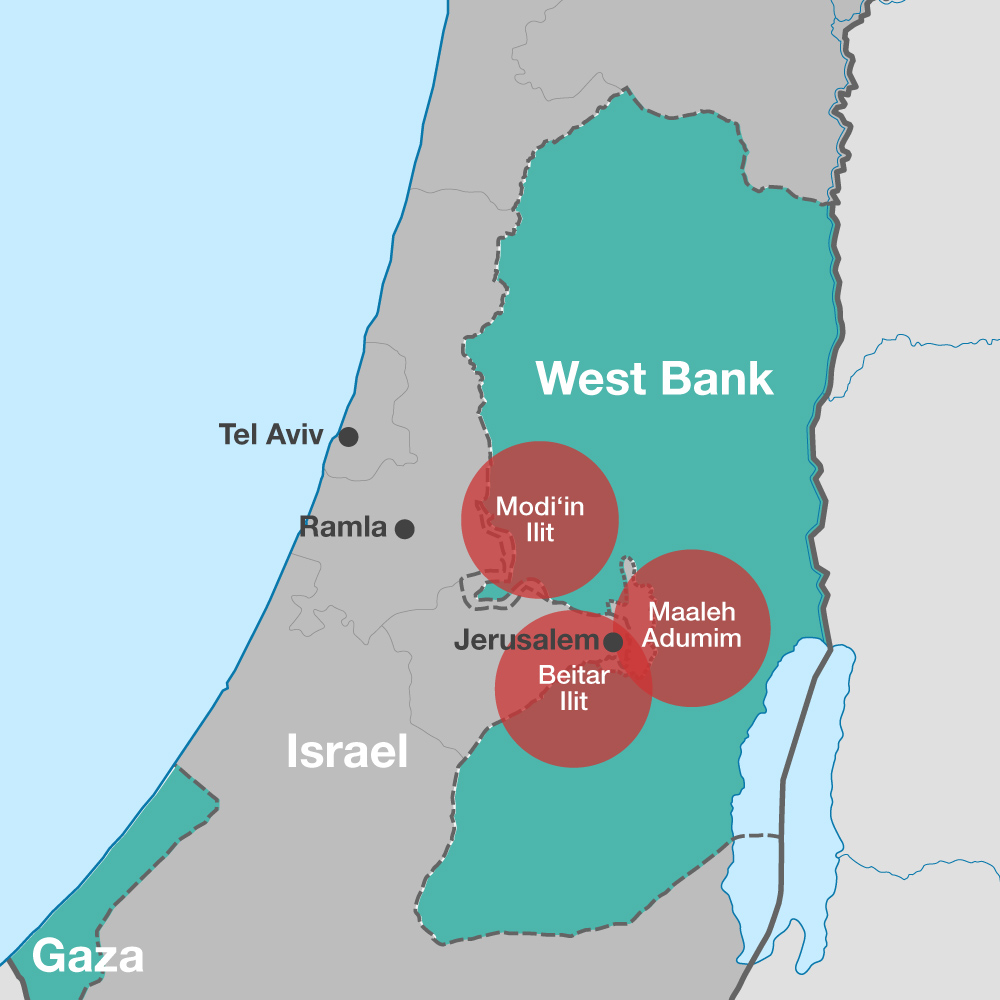
The purpose was to seal the fate of Jerusalem and thwart negotiations over the city in any future agreement.
The woman who first introduced the Jerusalem Law to the Israeli parliament, Geula Cohen, also believes that Israel could annex the entire West Bank “if Prime Minister Benjamin Netanyahu wills it”.
Israeli lawmakers are now making moves to annex three large settlement blocs in the occupied West Bank to the Israeli-defined boundaries of Jerusalem.
The so-called “Greater Jerusalem bill” would see the addition of 140,000 Jewish Israelis who live in these settlements to the population of Jerusalem, to ensure a Jewish majority in the city.
"The government will approve the Greater Jerusalem law that will strengthen the eternal capital Jerusalem - demographically and geographically," Yoav Kish, the Knesset member (MK) who submitted the proposal for the bill, said on Twitter.
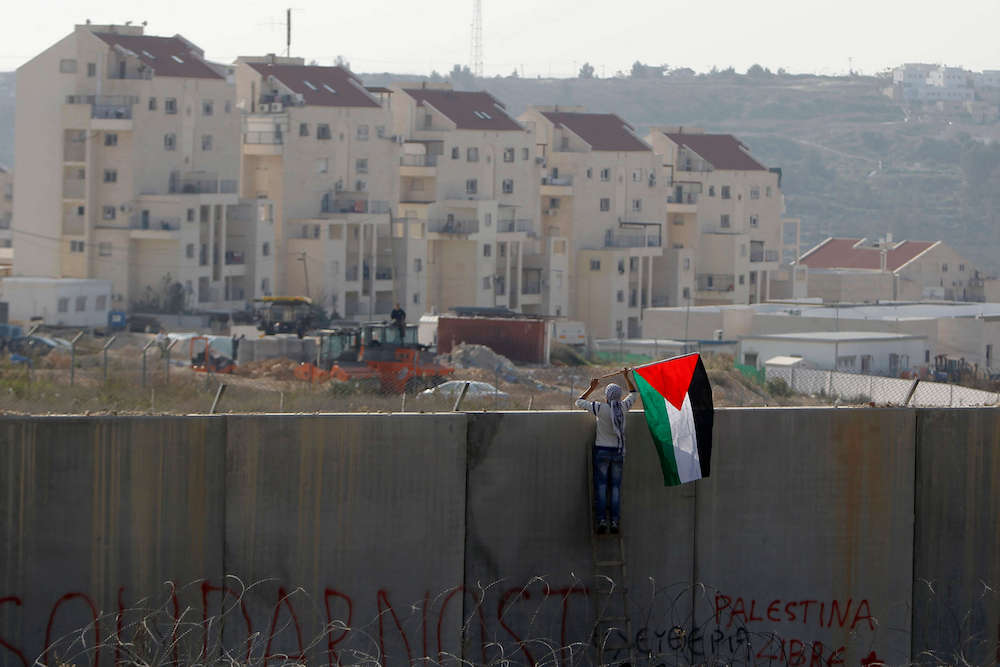
A man places the Palestinian flag on the controversial Israeli separation wall, with Israeli settlements showing in the background. Source: [REUTERS/Ammar Awad]
In 2004, Israel began building the separation wall, which was meant to provide “security” for Israelis by dividing between the West Bank and Israel following the second Palestinian uprising in 2000.
Israel has however used the wall to annex more land to its borders and has built it around some of the largest settlements in the West Bank, placing them on the “Israeli side”.
Some 85 percent of the wall falls inside the West Bank, and not on the Green Line. Palestinians have therefore aptly described the wall as an “annexation wall”.
In 2009, the Jerusalem municipality adopted a master plan intended "to guide and outline the city's development in the next decades”. The vision, as stated in the plan, is to create a ratio of 70 percent Israeli Jews to 30 percent Palestinians in the city.
Does Israel hope to annex the West Bank as well?
While many Israeli members of parliament hope to annex the entire West Bank - which they call by its biblical name, Judea and Samaria - there is a fear that bringing the territory into the boundaries of Israel would upset the population ratio by tipping the demographic balance in favour of the Palestinians in the country.
Annexing the West Bank would mean giving the 3.1 million Palestinians who live there Israeli citizenship and extending Israeli law, instead of martial law, to the area. Many see this as “an end to the Jewish state”, as Palestinians would outnumber Jewish Israelis.
But the growing settlement enterprise across the West Bank brings this possibility closer to reality every day.
Map shows Area C (in dark brown), and the route of the separation wall, which Israel has used to annex parts of the West Bank to East Jerusalem
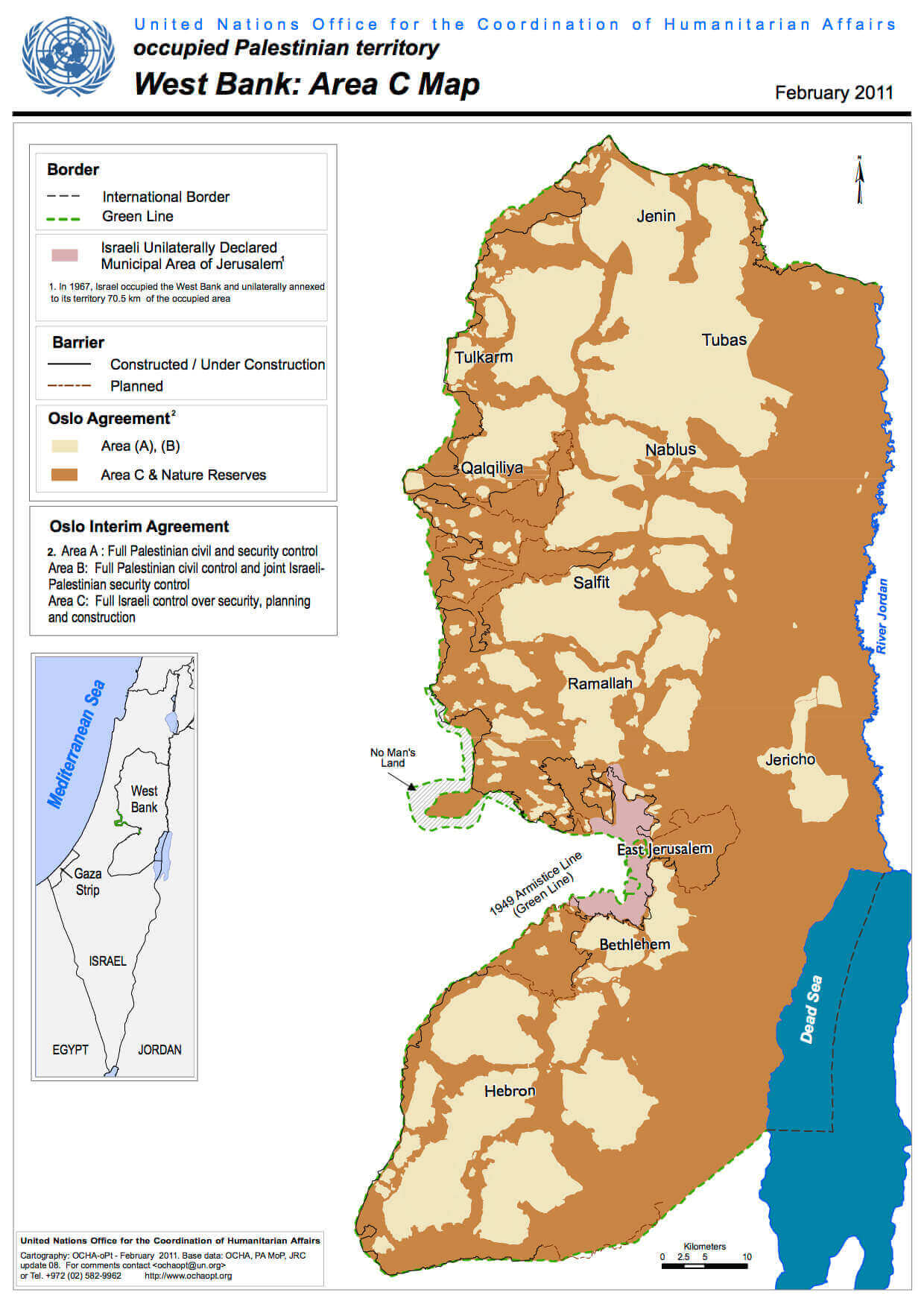 Source: United Nations Office for the Coordination of Humanitarian Affairs
Source: United Nations Office for the Coordination of Humanitarian Affairs
For some Israeli right-wing ministers, the annexation of Area C - which makes up 60 percent of the West Bank and is subject to total Israeli control - is a more realistic aim for the time being.
All the settlements are located in Area C, where some 300,000 Palestinians live - a figure consistently under-reported by Israeli politicians. Annexing the territory would mean that Israel could absorb the maximum amount of land with the least number of Palestinians.
The settlements in the West Bank are already connected to East Jerusalem and Israel through a series of Jewish-only roads that give the settlers the luxury of crossing the Green Line without having to pass through Palestinian population centres - as though they live in one single state.
The situation in Area C, where Israel consistently acts to minimise Palestinian presence through home demolitions, displacement, theft of resources and refusing to grant building permits, amounts to de facto annexation.
Quotes from Israeli politicians on annexation
"I believe that our right to the Land is absolute and unshakable and it that [sic] includes the entire Land [...] The correct policy, from the point of view of Israeli interests regarding our political ability at the moment, is to combine the attempt to hold the maximum amount of territory and apply sovereignty over the maximum amount of territory while keeping the Arab population within it to a minimum. This situation already exists in Area C, which is under our control; there are little more than 50,000 Arabs.”
Yariv Levin - 2014
“The only way to restore calm is to restore our sense of justice. To internalize that this is our Land. Exclusively. We must end the 'Occupation' and declare complete and exclusive sovereignty over all parts of the Land of Israel in our hands.”
Moshe Feiglin - 2015
“Citizens of Israel have paid in no end of victims, tens of thousands of missiles and no end of denunciations for this messianic policy of a Palestinian state. The conclusion is to stop marching toward the foolish path of a Palestinian state and to impose Israeli law on Ma'aleh Adumim, the Jordan Valley, Ofra, Ariel and all of Area C as soon as possible. This is how we win.”
Natfali Bennett - 2017
How do they impact Palestinians?
Besides being built illegally on private and public Palestinian land, settlements impact the day-to-day life of Palestinians in many ways.
In 2016, the UN found that the economy of the occupied Palestinian territories would be twice as large if the 50-year occupation were lifted.
Israel's policies of occupation and settlement have come to be seen as a purposeful strategy of de-development to weaken resistance to military rule and thwart attempts to build a successful Palestinian state.
Theft of resources
The settlements have only been able to thrive through severe economic exploitation of the occupied West Bank at the expense of the natives.
While the majority of the Palestinian population in the West Bank live in Areas A and B, the infrastructure upon which their livelihood depends either lies in or crosses into Area C.

Close to half of the Biet Owwa village (pictured) lies in Area C and has been severely affected by the settlements, checkpoints and the separation wall surrounding it. [5:28] Source: [REUTERS/Mussa Qawasma]
The area encompasses the territory's water resources, most fertile pasture and agricultural land, as well as mining and mineral extraction resources and tourist sites.
Palestinian access to Area C, some 60 percent of the West Bank, is either completely prohibited or highly restricted, causing an annual loss of $3.4bn to the economy.
Water
Israel controls some 90 percent - about six times more of the water resources.
Israeli settlers use about six times more water than the 3.1 million Palestinians in the West Bank do.
Jordan Valley and Dead Sea
The Jordan Valley and the northern part of the Dead Sea are the most fertile areas in the West Bank.
Some 40 percent of the dates produced in the occupied Jordan Valley settlements are exported by Israel to the European Union.
Israeli companies generate some $3bn annually from the sale of Dead Sea minerals.
Annual Israeli revenue from the exploitation of Palestinian land and resources in these areas is estimated at about $130 million.
QUARRIES AND STONE MINING
Since 1994, Israel has refused to issue new permits to Palestinian stone mining and quarrying companies - the largest Palestinian industry - while operating some 11 quarries for Israeli use.
Israel's virtual ban on Palestinian permits for quarries costs the Palestinian economy at least $241 million per year.
About 75 percent of the production of Israeli-operated quarries in the occupied West Bank is used in Israel.
AGRICULTURE
Palestinians are deprived of access to 85 percent of the grazing lands in the entire West Bank.
Only 21 percent of cultivable land is being utilized.
Restrictions by Israel on the importation of fertilisers add some $28 million to the costs borne by producers.
Freedom of movement and the separation wall Israel uses various methods to hinder Palestinian movement in the West Bank for the protection of Israeli settlers.

Palestinians cross through the Israeli Qalandia military checkpoint near the occupied West Bank city of Ramallah Source: [REUTERS/Ammar Awad]
- By the end of 2016, there were 572 obstacles to the free movement of Palestinians, including military checkpoints and roadblocks, in the occupied West Bank.
- The separation wall has physically separated Palestinian communities from one another and added hours to otherwise short commutes.
- Palestinians in certain areas must cross a checkpoint to enter and exit their villages.
Settler violenceDue to the close proximity of settlements to Palestinian homes, friction and violence between settlers and Palestinians is a near-daily reality.

A Palestinian boy sits on his bicycle as he looks at a torched car in the Palestinian village of Zubeidat in the Jordan Valley in 2013. Source: [REUTERS/Mohamad Torokman]
- In the first half of 2017, the UN documented 89 incidents in which Israeli settlers killed or injured Palestinians or damaged Palestinian property.
- The main forms of violence by Israeli settlers include throwing stones at Palestinian homes and vehicles, physically assaulting Palestinians, uprooting or damaging olive trees, vandalising property, or setting fire to agricultural lands.
- In 2016, more than 1,500 Palestinian olive trees were damaged or uprooted by settlers, in addition to 2.5 million trees uprooted since 1967.
- The overwhelming majority of complaints filed against settler violence pass without any punishment of the perpetrators.
Home demolitionsWhile building homes for settlers, Israel employs a policy of home demolitions to restrict the expansion of Palestinian communities on the pretext that homes were built without necessary permits, while refusing to issue them.
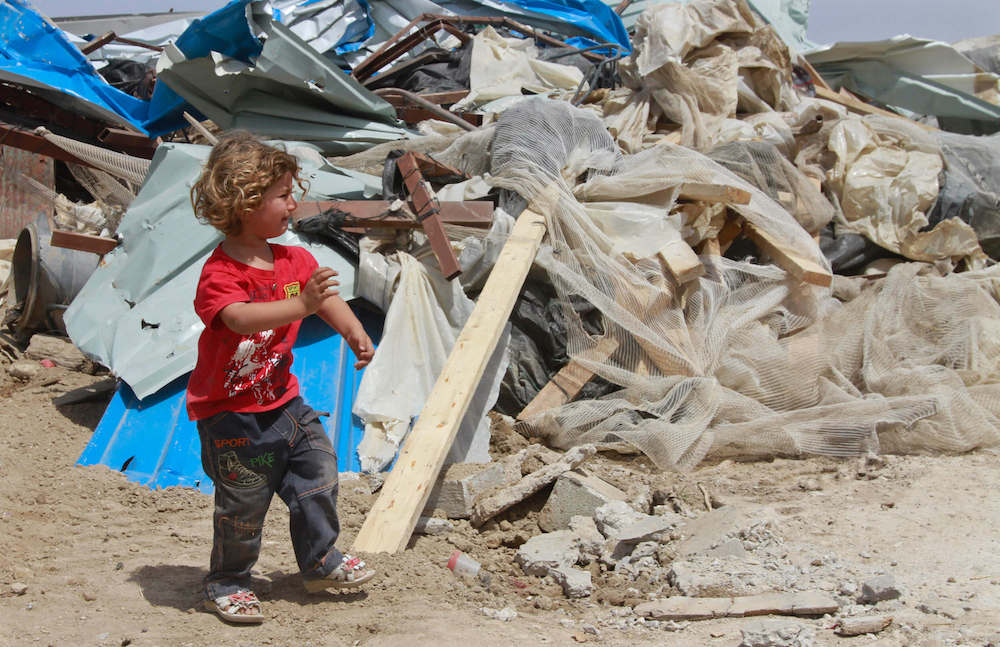
A Palestinian girl cries as she walks past her family's house after it was demolished by Israeli bulldozers in Om Ajaj village, north of the occupied West Bank city of Jericho Source: [REUTERS/Abed Omar Qusini]
- Since 1967, Israeli authorities have demolished over 27,000 Palestinian homes in the occupied territory.
- Between 2000 and 2007, Israeli authorities rejected more than 94 percent of permit requests in Area C.
- Demolitions of homes and other structures that forcibly displace Palestinians may amount to war crimes.
Additional reporting by Duha Allawi & Linah Alsaafin
 1 of 1
1 of 1